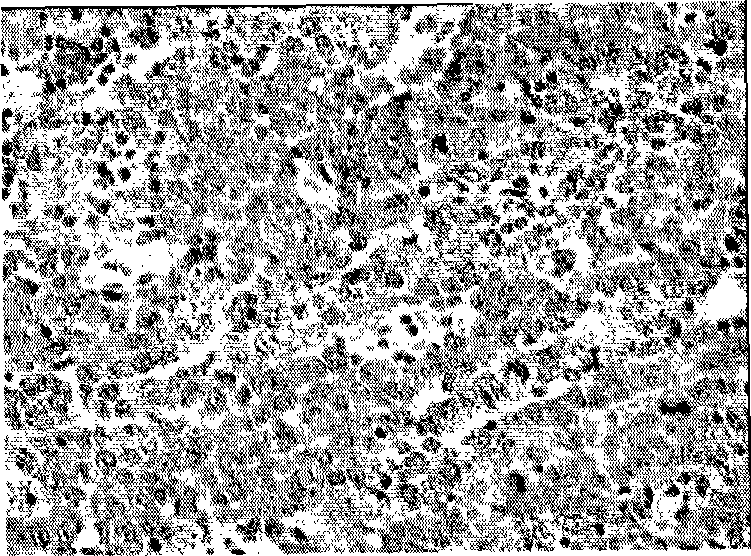Molecule mark for diffuse large b-cell lymphoma treating guide and prognosis judgment
A lymphoma, B cell technology, applied in the field of hematology oncology and medicine, can solve the problem of not providing DLBCL histological heterogeneity and prognostic molecular markers
- Summary
- Abstract
- Description
- Claims
- Application Information
AI Technical Summary
Problems solved by technology
Method used
Image
Examples
Embodiment 1
[0085] Example 1. Specimen collection
[0086] The cases included in this study were 73 newly diagnosed DLBCL patients, including 42 males and 31 females, aged 22-80 years, with a median age of 53 years. The following clinical data of patients were collected: gender, age, behavioral status, Ann Arbor clinical stage, LDH level, number of extranodal lesions, and tumor size, and were scored according to the International Prognostic Index (IPI). The patients signed the informed consent according to the requirements of the institution. Patients received 6 courses of standard dose CHOP or R-CHOP regimen, with or without radiotherapy according to the condition.
[0087] The specific composition of the CHOP regimen is as follows: Cyclophosphamide 750mg / m 2 , static push, the first day; Adriamycin 50mg / m 2 , static push, the first day; vincristine 1.4mg / m 2 (maximum dose, 2.0 mg), intravenously, on day 1; and prednisone 60 mg, orally, on days 1-5.
[0088] The specific composition...
Embodiment 2
[0091] Example 2. Immunohistochemical detection and result judgment
[0092] 1. Tissue Sample Processing
[0093] The 73 DLBCL samples were all fixed in formaldehyde. After histological and immunohistochemical analysis, two senior pathologists determined the tissue type according to the 2001 WHO lymphoma classification criteria.
[0094] Cut 3 micron slices, conventional dewaxing, dehydration, microwave antigen retrieval and natural cooling for 30 minutes, 1.5% hydrogen peroxide to remove endogenous peroxidase, 1% bovine serum albumin (BSA) to block at room temperature for 20 minutes, add the following Primary antibody: anti-p-Akt (Cell Signaling Technology, Beverly, MA), anti-YB-1 (Cell Signaling Technology, Beverly, MA), incubated at 4°C overnight, Dako EnvisionHRP (Dako Cytomation) labeled secondary antibody, DAB color development, Gradient alcohol dehydration, xylene translucent, hematoxylin counterstained nuclei.
[0095] Select 10 representative fields of view under ...
Embodiment 3
[0099] Example 3. p-Akt, YB-1 detection results and curative effect analysis
[0100] 1. Immunohistochemical test results
[0101] The positive rates of p-Akt and YB-1 in DLBCL paraffin tissues were 54.8% (40 / 73) and 65.8% (48 / 73), respectively. Both p-Akt and YB-1 were positively localized in the cytoplasm, and stained in brownish-yellow uniform flakes. Strong YB-1 positive can be manifested as brown granular staining of cell membrane, perinucleus and nucleus. Such as Figure 1 ~ Figure 3 shown.
[0102] 2. The relationship between the expression of p-Akt and YB-1 and the prognosis under different treatment regimens
[0103] Among the 73 patients enrolled, the one-way X2 test showed that p-Akt - The overall effective rate of treatment for patients was 91.0%, p-Akt + The overall effective rate of the patients was 60.0%, and there was a statistical difference between the two (P=0.003). Similarly, those with positive expression of YB-1 had a low overall response rate ...
PUM
 Login to View More
Login to View More Abstract
Description
Claims
Application Information
 Login to View More
Login to View More - R&D
- Intellectual Property
- Life Sciences
- Materials
- Tech Scout
- Unparalleled Data Quality
- Higher Quality Content
- 60% Fewer Hallucinations
Browse by: Latest US Patents, China's latest patents, Technical Efficacy Thesaurus, Application Domain, Technology Topic, Popular Technical Reports.
© 2025 PatSnap. All rights reserved.Legal|Privacy policy|Modern Slavery Act Transparency Statement|Sitemap|About US| Contact US: help@patsnap.com



